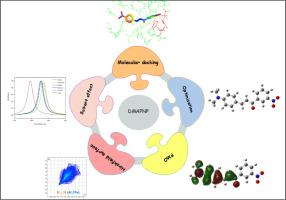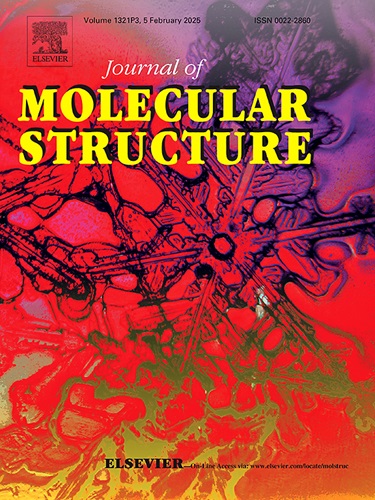A theoretical investigation into the impact of solvents (alkanolic and non-alkanolic), structural and spectroscopic properties, donor-acceptor insights, Hirshfeld surface, and molecular docking of the anti-tumor compound (2E)-3-[4-(dimethylamino)phenyl]-1-(3-nitrophenyl)prop‑2-en-1-one
IF 4.7
2区 化学
Q2 CHEMISTRY, PHYSICAL
引用次数: 0
Abstract
In this study, computational methods were employed to analyze the molecular structure of (2E)-3-[4-(Dimethylamino)phenyl]-1-(3-nitrophenyl)prop-2-en-1-one (DMAPNP), investigating its structural and spectroscopic properties along with its biological activity. In particular, the Frontier Molecular Orbital (FMO) and Molecular Electrostatic Potential (MEP) surfaces in alkanolic solvents (ethanediol, ethanol, and methanol) and non-alkanolic solvents (DMSO, toluene, and water) were generated to analyze the solvent-solute interactions. The H→L transition shows low oscillator strengths (0.0002 in toluene to 0.0013 in ethanediol, DMSO, and water), indicating limited significance in the absorption spectrum. In contrast, the H→L+1 transition has much higher oscillator strengths, around 0.9412 for ethanediol and 0.9385 for DMSO and toluene, suggesting a greater likelihood of absorption at these wavelengths. The simulated vibrational wavenumbers revealed the presence of CH, NO2, CN, CC, CH3, and C=O groups in DMAPNP. The calculated chemical shifts confirmed the molecular structure of DMAPNP and aligned with standard values. In Hirshfeld surface analysis, the crystal packing of DMAPNP was primarily stabilized by H…H interactions, contributing 41.3%, followed by O…H / H…O interactions at 30.9%. In Natural Bond Orbital (NBO) analysis, the interaction between C20-H38 and C15-H33 shows a stabilization energy of 1102.89 kJ/mol, highlighting σ-σ* transitions. In contrast, the C12-C16 and C15-H33 interactions exhibit a stabilization energy of 2542.16 kJ/mol, indicating substantial π-σ* contributions. In the Mulliken charge distribution, the carbon atoms C18 (-1.33704e) and C13 (1.776064e), located in the para and meta positions concerning the nitro group (NO2), exhibit the highest positive and negative potentials, respectively. Molecular docking assessed DMAPNP as a potential anti-tumor agent by inhibiting the key regulatory enzyme fructose-2,6-bisphosphatase, with a binding energy of -8.13 kcal/mol.

关于抗肿瘤化合物 (2E)-3-[4-(dimethylamino)phenyl]-1-(3-nitrophenyl)prop-2-en-1-one 的溶剂(烷醇和非烷醇)、结构和光谱特性、供体-受体见解、Hirshfeld 表面和分子对接的影响的理论研究
本研究采用计算方法分析了(2E)-3-[4-(二甲基氨基)苯基]-1-(3-硝基苯基)丙-2-烯-1-酮(DMAPNP)的分子结构,研究了其结构、光谱特性及其生物活性。特别是生成了烷醇溶剂(乙二醇、乙醇和甲醇)和非烷醇溶剂(二甲基亚砜、甲苯和水)中的前沿分子轨道(FMO)和分子静电位(MEP)表面,以分析溶剂与溶质之间的相互作用。H→L 过渡显示出较低的振荡强度(在甲苯中为 0.0002,在乙二醇、二甲基亚砜和水中为 0.0013),表明其在吸收光谱中的意义有限。相比之下,H→L+1 转变的振子强度要高得多,在乙二醇中约为 0.9412,在二甲基亚砜和甲苯中约为 0.9385,这表明在这些波长处吸收的可能性更大。模拟振动波数显示,DMAPNP 中存在 CH、NO2、CN、CC、CH3 和 C=O 基团。计算得出的化学位移证实了 DMAPNP 的分子结构,并与标准值一致。在 Hirshfeld 表面分析中,DMAPNP 的晶体结构主要由 H...H 相互作用稳定,占 41.3%,其次是 O...H / H...O 相互作用,占 30.9%。在天然键轨道(NBO)分析中,C20-H38 和 C15-H33 之间的相互作用显示出 1102.89 kJ/mol 的稳定能,突出了 σ-σ* 转变。相比之下,C12-C16 和 C15-H33 相互作用的稳定能量为 2542.16 kJ/mol,表明存在大量的 π-σ* 作用。在 Mulliken 电荷分布中,位于硝基(NO2)对位和元位的碳原子 C18(-1.33704e)和 C13(1.776064e)分别显示出最高的正电位和负电位。分子对接评估表明,DMAPNP 可抑制关键调节酶果糖-2,6-二磷酸酶,是一种潜在的抗肿瘤药物,其结合能为 -8.13 kcal/mol。
本文章由计算机程序翻译,如有差异,请以英文原文为准。
求助全文
约1分钟内获得全文
求助全文
来源期刊

Journal of Molecular Structure
化学-物理化学
CiteScore
7.10
自引率
15.80%
发文量
2384
审稿时长
45 days
期刊介绍:
The Journal of Molecular Structure is dedicated to the publication of full-length articles and review papers, providing important new structural information on all types of chemical species including:
• Stable and unstable molecules in all types of environments (vapour, molecular beam, liquid, solution, liquid crystal, solid state, matrix-isolated, surface-absorbed etc.)
• Chemical intermediates
• Molecules in excited states
• Biological molecules
• Polymers.
The methods used may include any combination of spectroscopic and non-spectroscopic techniques, for example:
• Infrared spectroscopy (mid, far, near)
• Raman spectroscopy and non-linear Raman methods (CARS, etc.)
• Electronic absorption spectroscopy
• Optical rotatory dispersion and circular dichroism
• Fluorescence and phosphorescence techniques
• Electron spectroscopies (PES, XPS), EXAFS, etc.
• Microwave spectroscopy
• Electron diffraction
• NMR and ESR spectroscopies
• Mössbauer spectroscopy
• X-ray crystallography
• Charge Density Analyses
• Computational Studies (supplementing experimental methods)
We encourage publications combining theoretical and experimental approaches. The structural insights gained by the studies should be correlated with the properties, activity and/ or reactivity of the molecule under investigation and the relevance of this molecule and its implications should be discussed.
 求助内容:
求助内容: 应助结果提醒方式:
应助结果提醒方式:


